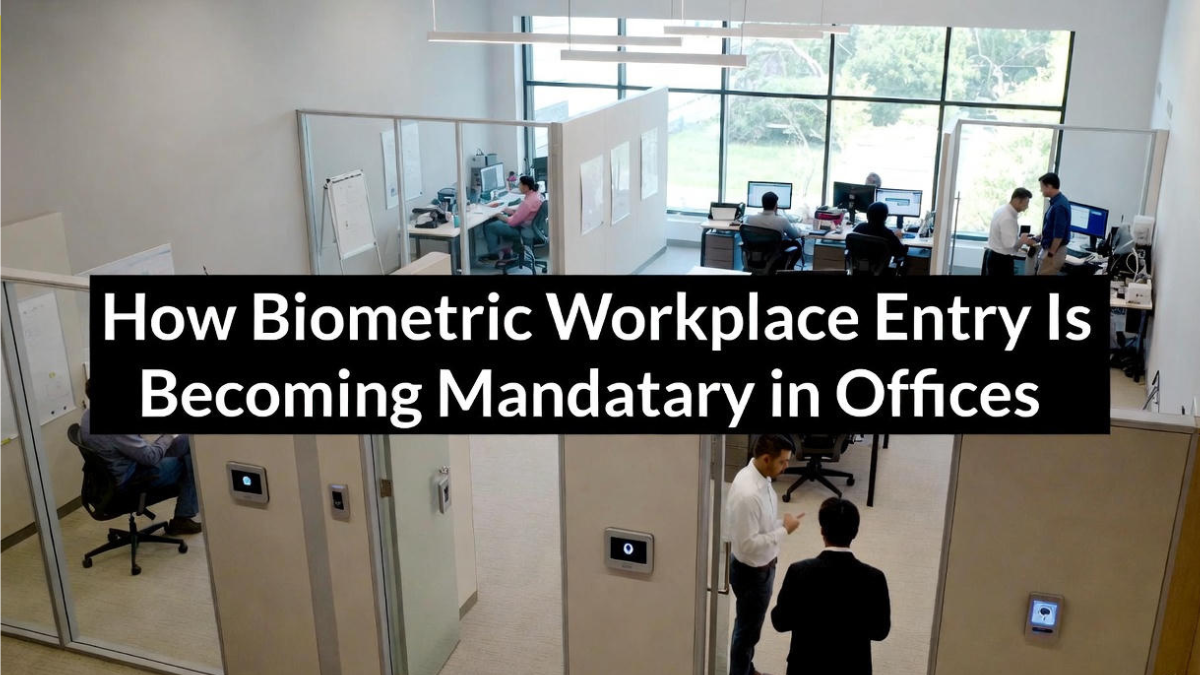The adoption of biometric office entry systems is rapidly transforming workplace security across India. As companies face increasing concerns about data breaches, unauthorized access, and employee safety, biometric systems offer a reliable and modern solution. These systems use fingerprints, facial recognition, iris scans, or palm scans to identify individuals with high accuracy. This growing shift aligns with the rising need for stronger employee verification processes, ensuring that only authorized personnel can access sensitive areas. As workplaces become smarter and more digital, biometric entry is becoming the new standard for seamless and secure office operations.

Why Offices Are Switching to Biometric Systems
Traditional ID cards and manual registers are no longer sufficient to protect modern corporate environments. They can be misplaced, shared, or manipulated easily. By contrast, biometric office entry offers unique, non-duplicable identification based on individuals’ physical characteristics. This reduces security risks and improves access control.
The rising demand for reliable employee verification also fuels this transition. Companies want to ensure precise attendance records, reduce proxy entries, and improve accountability. Biometric systems offer accuracy and real-time tracking, reducing administrative workload while enhancing security. With remote work and hybrid models becoming common, companies are investing more in entry systems that guarantee authenticity and minimize risks.
How Biometric Entry Enhances Workplace Efficiency
Beyond security benefits, biometric office entry greatly improves operational efficiency. It eliminates manual attendance systems, speeds up entry during peak hours, and helps HR teams maintain accurate working-hour records. Since biometric systems integrate easily with payroll and HR software, they simplify employee management.
Stronger employee verification also minimizes unauthorized visitors, reduces data leak risks, and ensures compliance with workplace safety standards. Offices with sensitive departments—such as finance, IT, and R&D—benefit significantly from restricted access zones controlled through biometric scans. This helps protect confidential information and maintain internal discipline.
Table: Biometric Entry vs Traditional Entry Systems
| Feature | Biometric Entry | Traditional Entry |
|---|---|---|
| Accuracy | Very high | Moderate |
| Risk of Duplication | Nearly zero | High |
| Attendance Tracking | Automated | Manual |
| Role in employee verification | Strong | Limited |
| Security Level | Advanced | Basic |
This comparison shows why biometric office entry systems are becoming essential for modern workplaces.
Types of Biometric Systems Used in Offices
Companies adopting biometric office entry can choose from various technologies based on their needs, budget, and infrastructure. Fingerprint-based systems remain the most common due to affordability and ease of use. However, facial recognition systems have become popular for contactless authentication, especially after the pandemic.
Iris and retina scanners offer even higher accuracy, making them ideal for high-security zones. Meanwhile, voice recognition and palm-vein scanning systems are emerging as new contenders. The rise of digital transformation means companies now combine multiple biometric tools to strengthen employee verification and reduce dependency on single-point authentication.
Benefits for Employees and Employers
The implementation of biometric office entry benefits both employers and employees. Employees enjoy faster entry, fewer manual checks, and improved workplace security. There is no need to carry ID cards or swipe badges—identity verification becomes automatic and seamless.
For employers, enhanced employee verification ensures efficient workforce management. It reduces administrative errors, prevents attendance fraud, and provides accurate audit trails. HR teams can generate attendance reports instantly, while security teams can review access logs in real time. This level of transparency builds trust and strengthens internal compliance.
Challenges in Implementing Biometric Systems
Despite the advantages, deploying biometric office entry systems comes with challenges. Some employees may have privacy concerns related to storage and use of biometric data. Companies must follow strict data protection rules to ensure confidentiality and prevent misuse.
Another challenge is system maintenance. Biometric scanners require regular updates, cleaning, and calibration. Internet outages or technical glitches can temporarily disrupt employee verification, highlighting the need for backup authentication methods. Additionally, certain biometric methods—like fingerprint scanning—may be less effective for workers dealing with chemicals or heavy equipment.
Future of Biometric Entry in Indian Workplaces
The future of biometric office entry is expected to grow rapidly as workplaces modernize. AI-driven facial recognition, touchless scanning, and multi-layer authentication systems will soon become standard features in offices. Cloud-based biometric systems will support hybrid work by enabling employee verification across different office locations.
As digital security becomes more critical, companies will increasingly rely on biometric systems to safeguard assets, data, and personnel. With innovation and regulatory support, biometric entry systems will continue to evolve into smarter, faster, and more secure workplace solutions.
Conclusion
The adoption of biometric office entry reflects India’s shift toward sophisticated, technology-driven workplace security. Supported by advanced employee verification systems, biometric entry ensures safety, efficiency, and transparency across office environments. Despite minor challenges, the technology is becoming a core component of modern corporate infrastructure, shaping the future of safe and smart workplaces in India.
FAQs
How do biometric entry systems improve office security?
They ensure only authorized individuals can enter, reducing risks of unauthorized access.
Why is biometric office entry becoming popular?
Because it provides faster access, accurate attendance, and stronger employee verification.
Are biometric systems safe for data privacy?
Yes, when companies follow secure data protection guidelines and encryption standards.
What types of biometric systems are used in offices?
Fingerprint, facial recognition, iris scanning, palm scanning, and voice-based authentication.
Click here to know more.